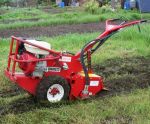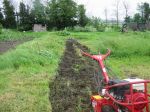Categories
Calendars
Guides
Reviews
Archive
Gallery
Articles
Ask Our Gardening Expert
How To Clear An Allotment (page 2)
GARDENACTION ALLOTMENT
Whilst clearing 90% of the height of the weeds and grass
you will probably have also cleared any large debris which is step 2
of clearing an allotment. If not, do it now.
When you do this, store any rubble or bricks for use later on when
mulching with black plastic, it will be useful in weighting it to the
ground.
If you are cutting down any twigs, save these as well to use as
supports for bean plants.
For step 3, we hired a rotovator to break up the soil surface.
The allotment owner next to us used a rake however and it was
definitely hard work. It also did little to break up the soil
surface. However, if money is short, using a rake is obviously the
way to clear the remaining weeds. It also has the benefit of
removing all surface weeds and dramatically reduces the chances of
weed and grass re-growth.
Before hiring a rotovator though, consider the following:
1.
What will the weather be like on the day you choose to
rotovate the allotment? If it's raining it's not really worth
rotovating an allotment, you will simply end up in a mud bath. So
keep an eye on the weather forecast a few days beforehand.
2.
Talk to the hire company a week or so beforehand and find out
if you need to book the rotovator. If you do need to book, what is
the deposit and what happens to your deposit if rain makes it
impossible to use the rotovator?
3.
How will you get the rotovator from the hire company to your
allotment? Many companies will deliver free but some won't or
charge for it.
4.
Is it feasible to get the rotovator from the entrance to the
allotments to your particular allotment?
If you hire a rotovator to break up the soil surface
don't expect too much. It will break up the top 5cm (2in) or so, which
is a great help, but it will not fully cultivate the ground. It will
also definitely require digging later. However, it will break up the
surface and make the digging task very much easier. Ask the hire shop which type of rotovator is best for
your allotment and take their advice. If you hire a rotovator which is
not up to the job it will be a waste of money. We ended up with a
powerful hydraulic rotovator and it was well worth the money.
The picture above (click it to enlarge it) shows the
result of one pass of the rotovator. We found it necessary to go over
the same ground twice and in some places three times.How To Clear An Allotment
(page 2)

 Also, don't underestimate the physical effort which will be
required to control the rotovator! It will follow contours in the
ground very strongly. Our advice is to hire the rotovator for one
day only. Any more is a waste of time unless you are Tarzan and
have loads of stamina. Do whatever you can in a day and deal with
the rest in a different way.
Also, don't underestimate the physical effort which will be
required to control the rotovator! It will follow contours in the
ground very strongly. Our advice is to hire the rotovator for one
day only. Any more is a waste of time unless you are Tarzan and
have loads of stamina. Do whatever you can in a day and deal with
the rest in a different way.